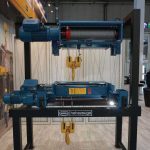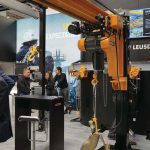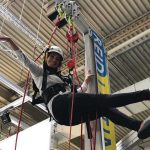Many of Europe’s major hoist manufacturers attended the CeMat and Messe Hannover show in Germany in late April. Daniel Searle attended the exhibition.
The story coming from the Western markets of Europe and North America during recent trade exhibitions was consistently one of steady, cautious positivity. At both Logimat in Stuttgart, Germany and at Modex in Atlanta, Georgia, USA, exhibitors discussed how recent growth has been steady and controlled. What’s more, with the memory of the 2008 economic crash all too fresh in certain industry sectors and geographical regions, many members of the industry are quite happy with this situation, rather than having to navigate the associated risk of a bust that always accompanies a boom.
The growth is being driven not just by the gradual recovery of markets following the recession, but also by a focus on continual improvements to the technology available. While the physics of lifting a load may remain the same as it ever was, the latest generation of lifting equipment further improves the efficiency and capability of end users’ operations.
At CeMat and Messe Hannover—the two shows were held together for the first time this year—the industry showcased not just the digital technology that has defined recent years through the trend dubbed ‘Industry 4.0’ but also innovations in traditional mechanical engineering. Many of the stands at the show were open-sided to allow full-scale cranes and hoists to be displayed.
Kuli’s stand was dominated by a 20t hoist with two falls, which after the show was due to be delivered to a manufacturer of forgings, for installation at its outdoor storage facility.
Also on show was a compact hoist on a double-girder crane, which demonstrated one of the company’s approaches to its fully in-house production. The design of the hoist frame with modular mounting plates and wheel blocks accommodate different configurations, explained managing director Oliver Kempkes, such as single-girder and double-girder cranes, as well as low headroom and twin hoist set-ups. This ability to use the same design of component for different standard configurations, as well as customised solutions, is one of the ways the company keeps prices down, he added.
“The market and economy are good at the moment,” said Kempkes, before adding a caveat: “However, the increased number of orders does mean that delivery times have to be slightly longer.”
LiftKet, a manufacturer of electric chain hoists, also offers a twin hoist system. Although the technology isn’t required by the company’s customers regularly, said deputy head of sales Tom Schumann, it shows the capability the company has.
“The Twin Hoist is used for lifting long loads, for example drums or rolls of paper or steel,” explained Schumann. “It features a synchronised hoist, which is mechanical rather than electronic and uses a mechanical interlock.”
The company, which is based near Leipzig and has around 250 staff, supplies hoists for industrial applications, the entertainment sector, and customised projects such as wind turbines.
Its latest technology is the Star VFD hoist with frequency inverter; a prototype was on display at the exhibition with the system, which is currently in testing, due to be launched in the fourth quarter of 2018. The Star VFD offers a range of features including the ability to lift at double speed when not under load; a display on the unit showing real-time load measurement; and the ability to constantly monitor the usage of the hoist, in terms of both time and the weight of the load, and calculate the number of full-load hours completed by the hoist. The unit will initially be able to lift loads of up to 2t, added Schumann.
Spain’s GH introduced its Twin Hoist system, which is based on the standard hoists manufactured by the company, and is designed to provide vertical lifting without lateral displacement; a reduction in the stress on structures caused by starting and braking during lifting; and increased safety, as in the incident of one rope breaking, the load is still suspended by the remaining three ropes.
Erikkila is now fully-owned by Kito Europe, which also acquired 37.5% of Van Leusden in April. Between the companies, they can supply a full system including hoists, rails or tracks, and hooks.
Erikkila demonstrated its Prosystem light crane system with internal conductor rail as standard, in both aluminium and steel models. Also available on jib cranes, the technology means that there are no external cables, making it easier and safer to move.
The ProSystem enables hoist operation both through a remote control and manually, as well as automatically slowing as it reaches the end of a beam. Also being promoted were the company’s hoist tracks, available as both straight or curved systems.



没有评论:
发表评论